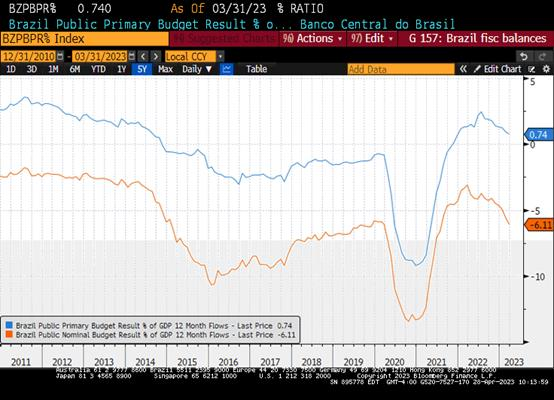EM Rates – Choose Wisely
28 April 2023
Read Time 2 MIN
Exiting EM Tightening Cycles
The market is gearing for another rate hike by the U.S. Federal Reserve (Fed) next week and more policy tightening in Europe. In the meantime, emerging markets (EM) central banks are moving in different directions. Many opt to stay on hold, despite successful disinflation, due to widespread concerns about sticky core prices and high inflation expectations. Factors like Brazil’s fiscal uncertainty (see chart below) and a potentially larger minimum wage increase can easily contribute to the latter.
EM Rate Cuts
Several EMs outside of China are testing the waters with inaugural rate cuts – Uruguay, Costa Rica and Hungary’s Lombard rate cut – betting on a combination of a very supportive base effect and weakening domestic activity. However, these attempts are generally met with skepticism by the market (=weaker currencies), because there are plenty of headline risks (Argentine mega-drought, OPEC’s production cuts, El Nino) and policy reversals can be costly (including credibility).
EM Rate Hikes
Finally, there are still some EM rate hikes in the pipeline. Of course, Argentina’s gargantuan +1000bps (!) move yesterday is a sign of desperation (as the underlying reasons for triple-digit inflation and other imbalances are still in place), but the consensus added a more reasonable 25bps “insurance” rate hike for Colombia in the wake of the cabinet reshuffle. The tightening cycle might also not be over in South Africa and Thailand. Thailand could be a victim of its own success, as demand-side price pressures might increase on the back of stronger tourist arrivals (including China) and faster GDP growth. Stay tuned!
Chart at a Glance: Brazil’s Fiscal Path – A Wrong Turn1

Source: Bloomberg LP.
1 Brazil's Public Primary Budget (BZPBPR Index) balance excludes debt servicing costs (payments of interest and amortizations of the public debt, as well as state and municipal loans).
Related Insights
IMPORTANT DEFINITIONS & DISCLOSURES
This material may only be used outside of the United States.
This is not an offer to buy or sell, or a recommendation of any offer to buy or sell any of the securities mentioned herein. Fund holdings will vary. For a complete list of holdings in VanEck Mutual Funds and VanEck ETFs, please visit our website at www.vaneck.com.
The information presented does not involve the rendering of personalized investment, financial, legal, or tax advice. Certain statements contained herein may constitute projections, forecasts and other forward looking statements, which do not reflect actual results. Information provided by third-party sources are believed to be reliable and have not been independently verified for accuracy or completeness and cannot be guaranteed. Any opinions, projections, forecasts, and forward-looking statements presented herein are valid as of the date of this communication and are subject to change without notice. The information herein represents the opinion of the author(s), but not necessarily those of VanEck.
The views contained herein are not to be taken as advice or a recommendation to buy or sell any investment in any jurisdiction, nor is it a commitment from Van Eck Associates Corporation or its subsidiaries to participate in any transactions in any companies mentioned herein. This content is published in the United States. Investors are subject to securities and tax regulations within their applicable jurisdictions that are not addressed herein.
All investing is subject to risk, including the possible loss of the money you invest. As with any investment strategy, there is no guarantee that investment objectives will be met and investors may lose money. Diversification does not ensure a profit or protect against a loss in a declining market. Past performance is no guarantee of future results.
